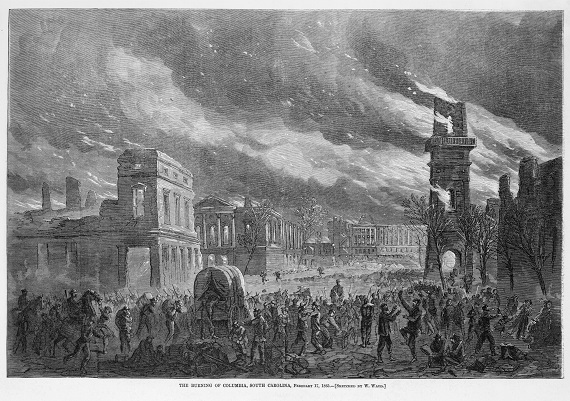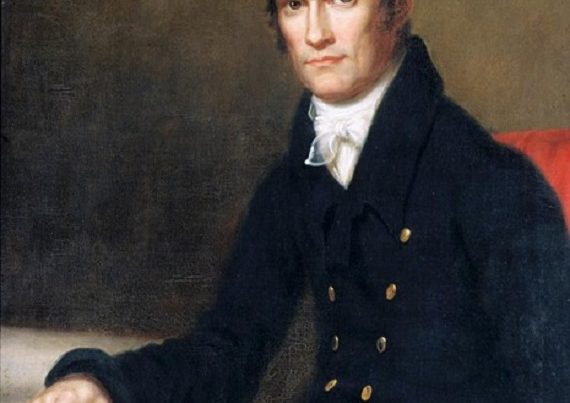The diary of Emma LeConte is one of the best known documents chronicling the sack and destruction of Columbia, South Carolina. On February 17, 1865, the city surrendered to the besieging army of General William T. Sherman. His soldiers pillaged the city throughout the day and in the evening set fires that would destroy much of the place. Emma LeConte’s family resided on the campus of South Carolina College (now the University of South Carolina), and because there was a hospital there housing some Federal soldiers as patients, this area was mostly spared from the flames.
Emma’s diary contains her vivid, passionate reports of all that was going on around her, painting an unforgettable picture of destruction, horror and tragedy. She wrote of how the soldiers exulted in the destruction of the city, reporting that though at first they tried to make excuses for the fires, one of them frankly admitted “that Sherman had ordered them to burn it, that they expected to burn it, and that they did burn the hole of secession.”
Emma came from a distinguished family. Her father, Joseph LeConte, was born in Liberty County, Georgia, and after a medical education, he practiced in Macon for a few years, after which he attended Harvard and studied natural sciences and geology under the famous scientist Louis Agassiz. Eventually Joseph LeConte became a professor of chemistry and geology at South Carolina College in Columbia, and during the war, he helped to manufacture medicines for the Confederacy, and also served in the Confederate Nitre and Mining Bureau. A few years after the war, finding life under the carpetbagger government intolerable, he applied for employment at the new University of California in Berkeley. He was elected to a professorship (in geology, natural history and botany) and moved there in September 1869. In 1892, concerned about the preservation of the Sierra Nevada mountain range, LeConte became one of the founders of the Sierra Club.
Emma’s uncle John LeConte was a professor of physics at South Carolina College. He and his wife Josephine, who are frequently mentioned in Emma’s diary, lived in a fine brick house on the corner of Pendleton and Sumter streets. Built by the college in 1860, it was known as the “Fourth Professor’s House.” During the night and early morning hours of February 17th, several attempts were made to burn it by Sherman’s soldiers.
In a letter that Josephine LeConte wrote about ten days later, she recalled:
“All night long from the Piazza and roof the women fought the flames and there were times when the panes of glass were so hot that you could not rest your hand there for any time but still we fought —and there stood that sea of upturned faces of Logan’s Corps with not one spark of sympathy for us … At daylight the flames began to subside and I threw myself upon the bed to rest when tramp, tramp, tramp, resounded through the house, upon rising, [I] found that half dozen fellows had entered the house from the Kitchen, declaring the house was on fire, rushed up to the garret pretending to put out the fire—when lo and behold they tore up the tin [roof] and deliberately set my house afire.”
Fortunately, the presence of an able-bodied man in the house, a friend named Dr. Carter, as well as the heroic efforts of the LeConte ladies, preserved the house from destruction. Josephine’s letter records other horrors of the night:
“They burned the Ladies Hospital — fortunately all the sick were removed to our [campus] Hospital during the day except the corpse of one man. During the carnival of death and destruction a number of their own men sought a bed there as their beastly intoxication could carry them no farther—these were burned up. As the flames progressed they could be seen tearing their hair and screaming for help—but help there was none—and when the building fell in they all perished. Instantly the yells of delight filled the air, frantically they advanced, severed the heads from the bodies, caught them up on their bayonets, and danced around to the tune of ‘damnation to the rebels’ little dreaming that they were their own men.”
Emma’s diary covers a period from December 1864 to August 1865, and though brief (less than 120 pages), it is powerful and moving, and is highly recommended for anyone interested in one of the darkest hours in the history of the war and the state of South Carolina.[1]
[1] The (mostly) unpublished papers of Joseph, John, and Josephine LeConte are housed at the Bancroft Library at UC Berkeley. Emma’s diary is in the Southern Historical Collection at UNC Chapel Hill. It was first published in 1957 as When the World Ended, and a new edition by Dr. James E. Kibler is in the works.







